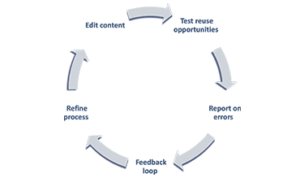Articles
Various standards for Industry 4.0
An automation through computers has long been integrated into industrial production – now it is slowly but surely advancing further. We are talking about Smart Factories, Cloud Computing, and the Internet of Things: Industry 4.0.
Increasing digitalization and intelligent networking of machines save time and resources and open up new possibilities along the entire value chain. To enable an information-driven production, where information is machine-readable and exchangeable, standards need to be established. They help in describing products and pave the way for intelligent information delivery. For Technical Communication, the standards ECLASS, VDI 2770, and iiRDS are relevant. We want to provide some clarity: How do these standards differ from each other, and where do they intersect?
Standards in Technical Documentation
The ECLASS Standard
ECLASS is a manufacturer- and industry-independent data standard with ISO-compliant features that was developed 20 years ago by the association of large German industrial companies with the same name. The ECLASS Standard classifies products and services into 4 hierarchical levels, consisting of classes, keywords, characteristics, values, and units. This allows all products and services to be described unambiguously. With the standardized master data, processes in data management, controlling, and sales can be made more efficient and effective. The data can be intelligently provided and digitally exchanged, thus delivering added value along the entire value chain.
ECLASS describes products and services, not their documentation, as is the case with the iiRDS and VDI 2770 standards. However, ECLASS can be used in VDI 2207 for object referencing with IRDIs, and a synergy between ECLASS and iiRDS is possible and meaningful. More on that later.
VDI 2770 Standard
The VDI e.V. (Association of German Engineers) develops cross-industry technical guidelines. The VDI 2770 Standard Sheet 1 (Operation of process engineering plants – Minimum requirements for digital manufacturer information for the process industry – Basics) describes the standardized nature of digital manufacturer information. It defines the classification, structure, metadata, and file formats of information, thus providing a structured and standardized delivery of information. The standard is intended to simplify process flows in the output of information, both on the side of manufacturers, operators, and users. In addition to internal information, supplier documents can also be integrated.
Documents are classified, meaning they are categorized into groups and sections and saved as PDF. Additionally, an XML document with metadata is created, and both are then stored in a ZIP container. The VDI 2270 standard describes complete documents in a package.
iiRDS – intelligent information Request and Delivery Standard
iiRDS stands for the intelligent information Request and Delivery Standard, enabling platform-independent and content-neutral querying and delivery of digital information. The standard is based on a modular structure of information and metadata that provides a detailed description and linkage of information. iiRDS essentially consists of three components – a package format that allows the exchange between different content systems, a metadata model that classifies and makes information combinable, and a specification that describes the package format and metadata concept. iiRDS does not standardize content itself but defines the delivery format to enable the consolidation of information from different systems. Specifically, this means that information from different CMS is standardized with iiRDS and can be provided through a central content delivery portal. iiRDS was developed by an expert group of tekom (Society for Technical Communication e.V.) in 2016 to fundamentally change the provision of information in technical communication. Learn more about iiRDS here.
Interplay of Standards
iiRDS and VDI 2270 initially developed separately and in parallel. Both standards enable the provision and digital exchange of technical documentation. However, the VDI standard mainly focuses on the process industry and describes entire documents of technical documentation. On the other hand, iiRDS also offers a metadata concept but typically describes individual topics, which are smaller information units that can be modularly assembled.
iiRDS is not intended to be an isolated standard but rather a bridge between standards. Therefore, the iiRDS consortium and VDI have decided to collaborate and adapt the standards to complement each other and be compatible. The latest version of iiRDS allows the creation of nested packages, forming a hybrid package from iiRDS and VDI 2770.
Since 2020, there has been a cooperation between ECLASS e.V. and the iiRDS consortium to describe, differentiate, and highlight potential shared between the two standards. Core metadata from iiRDS is intended to be integrated into ECLASS.
ECLASS describes data related to products, not their documentation. iiRDS is designed for technical documentation. Due to the open nature of the standard, iiRDS can link the metadata that classifies products with the corresponding documentation, presenting them as a cohesive unit.
What does the future hold?
One thing is certain: the progressive digitization will make intelligent information provision and utilization indispensable. This requires metadata, cross-domain models, and standardized formats that allow information retrieval from various systems and establish semantic relationships. The development and further convergence of these standards will unfold in the future.
Subscribe to the free newsletter of PANTOPIX.
We will gladly keep you informed about new articles regularly.

From Legacy Systems to DITA: Case Studies in Successful Migration
This article explores real-world insights and lessons learned from successful migration projects, based on two case studies facilitated by PANTOPIX.

Knowledge Graphs and Large Language Models: the perfect combination!
Out-of-the-box solutions for RAG systems are becoming increasingly widespread. They promise to make a company’s knowledge accessible from documents such as PDFs or Word files using Large Language Models (LLMs) in the form of a chat.

Semantic layers of the Product Information Management Systems (PIM)
Companies rely on Product Information Management (PIM) systems to create, manage, and distribute product information across various channels. We can offer PIM systems software solutions for our industrial clients.
Contact us
Karsten Becke
Managing Director
- karsten.becke@pantopix.com

